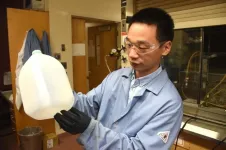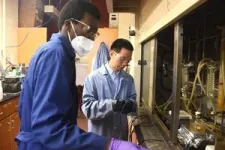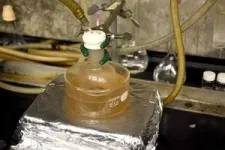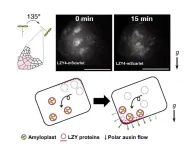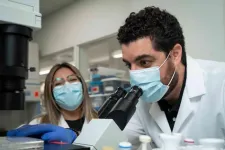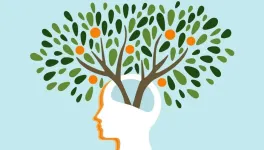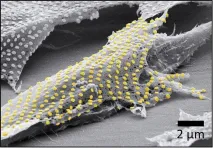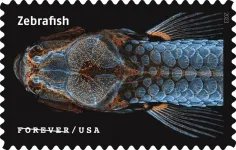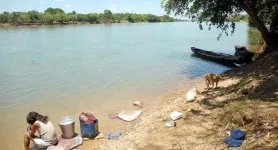(Press-News.org) A team led by Virginia Tech researchers has developed a new method for upcycling plastics into high-value chemicals known as surfactants, which are used to create soap, detergent, and more.
Plastics and soaps tend to have little in common when it comes to texture, appearance, and, most importantly, how they are used. But there is a surprising connection between the two on a molecular level: The chemical structure of polyethylene — one of the most commonly used plastics in the world today — is strikingly similar to that of a fatty acid, which is used as a chemical precursor to soap. Both materials are made of long carbon chains, but fatty acids have an extra group of atoms at the end of the chain.
Guoliang “Greg” Liu, associate professor of chemistry in the Virginia Tech College of Science, had long felt this similarity implied that it should be possible to convert polyethylene into fatty acids — and with a few additional steps to the process — to produce soap. The challenge was how to break a long polyethylene chain into many short — but not too short — chains and how to do it efficiently. Liu believed there was the potential for a new upcycling method that could take low-value plastic waste and turn it into a high-value, useful commodity.
Having considered the question for some time, Liu was struck by inspiration while enjoying a winter evening by a fireplace. He watched the smoke rise from the fire and thought about how the smoke was made up of tiny particles produced during the wood’s combustion. Although plastics should never be burned in a fireplace for safety and environment reasons, Liu began to wonder what would happen if polyethylene could be burned in a safe laboratory setting. Would the incomplete combustion of polyethylene produce “smoke” just like burning wood does? If someone were to capture that smoke, what would it be made of?
“Firewood is mostly made of polymers such as cellulose. The combustion of firewood breaks these polymers into short chains, and then into small gaseous molecules before full oxidation to carbon dioxide,” said Liu, holder of the Blackwood Junior Faculty Fellowship of Life Sciences in the Department of Chemistry. “If we similarly break down the synthetic polyethylene molecules but stop the process before they break all the way down to small gaseous molecules, then we should obtain short-chain, polyethylene-like molecules.”
With the help of Zhen Xu and Eric Munyaneza, two Ph.D. chemistry students in Liu’s lab, Liu built a small, oven-like reactor where they could heat polyethylene in a process called temperature-gradient thermolysis. At the bottom, the oven is at a high enough temperature to break the polymer chains, and at the top, the oven is cooled to a low enough temperature to stop any further breakdown. After the thermolysis, they gathered the residue — similar to cleaning soot from a chimney — and found that Liu’s hunch had been right: It was composed of “short-chain polyethylene,” or more precisely, waxes.
This was the first step in developing a method for upcycling plastics into soap, Liu said. Upon adding a few more steps, including saponification, the team made the world’s first soap out of plastics. To continue the process, the team enlisted the help of experts in computational modeling, economic analysis, and more.
Some of these experts were introduced to the team through connections with the Macromolecules Innovation Institute at Virginia Tech. Together, the group documented and refined the upcycling process until it was ready to be shared with the scientific community. The work was published today in Science.
“Our research demonstrates a new route for plastic upcycling without using novel catalysts or complex procedures. In this work, we have shown the potential of a tandem strategy for plastic recycling,” said Xu, lead author on the paper. “This will enlighten people to develop more creative designs of upcycling procedures in the future.”
Although polyethylene was the plastic that inspired this project, the upcycling method can also work on another type of plastic known as polypropylene. These two materials make up much of the plastic consumers encounter every daily, from product packaging to food containers to fabrics. One of the exciting features of Liu’s new upcycling method is that it can be used on both these plastics at once, meaning that it’s not necessary to separate the two from each other. This is a major advantage over some recycling methods used today, which require careful sorting of plastics to avoid contamination. That sorting process can be quite difficult, because of how similar the two plastics are to each other.
Another benefit of the upcycling technique is that it has very simple requirements: plastic and heat. Although the later steps in the process require some additional ingredients to convert the wax molecules into fatty acids and soap, the initial transformation of the plastic is a straightforward reaction. This contributes to the method’s cost-effectiveness as well as its comparatively small environmental impact.
For upcycling to be effective on a large scale, the final product must be valuable enough to cover the costs of the process and make it more economically attractive than alternative recycling options.
Although soaps may not initially seem like a particularly expensive commodity, they can actually be worth double or triple the price of plastics when compared by weight. Currently, the average price of soap and detergent amounts to about $3,550 per metric ton, and that of polyethylene is about $1,150 per metric ton. Furthermore, the demand for soaps and related products is comparable to the demand for plastics.
This research lays the groundwork for a new way to reduce waste by channeling used plastics into the production of other useful materials, Liu said. Over time, he hopes recycling facilities around the world will begin to implement this technique. If so, then consumers can expect to one day have the opportunity to buy revolutionary sustainable soap products that also lead to reduced plastic waste in landfills.
For this reason, turning plastics into soaps can be demonstrated to be economically viable, added Liu, who is also an affiliated faculty member of the nanoscience program, part of the College of Science’s Academy of Integrated Science as well as the Department of Materials Science and Engineering in the Virginia Tech College of Engineering.
“It should be realized that plastic pollution is a global challenge rather than a problem of a few mainstream countries. Compared to a sophisticated process and complex catalyst or reagent, a simple process may be more accessible to many other countries worldwide,” Xu said. “I hope this can be a good start for the war fighting plastic pollution.”
Researchers from the Department of Chemical Engineering also were part of this project and the resulting research paper.
Related stories
Virginia Tech researcher finds a new method for recycling polystyrene
Multifunctional porous carbon fibers show significant promise in capacitive desalination
END
An unexpected way to upcycle: Plastic waste transforms into soap
Guoliang “Greg” Liu of the Department of Chemistry has discovered a new method of recycling plastics — from milk cartons, food containers, and plastic bags — into soap. The method: Heat the long carbon chains in the plastics then quickly cool them
2023-08-10
ELSE PRESS RELEASES FROM THIS DATE:
The positional transmitter of statoliths unveiled: It keeps plants from getting lazy
2023-08-10
Plants orient their organs in response to the gravity vector, with roots growing towards gravity and shoots growing in the opposite direction. The movement of statoliths responding to the inclination relative to the gravity vector is employed for gravity sensing in both plants and animals. However, in plants, the statolith takes the form of a high-density organelle, known as an amyloplast, which settles toward gravity within the gravity sensing cell. Despite the significance of this gravity sensing mechanism, the exact process behind it has eluded scientists ...
City of Hope researchers develop a CAR T cell therapy for advanced ovarian cancer
2023-08-10
LOS ANGELES — There are currently few effective treatment options for patients with recurrent ovarian cancer and other solid tumors, but City of Hope researchers are trying to change that.
Researchers with City of Hope, one of the largest cancer research and treatment organizations in the nation, have published preclinical research in Nature Communications demonstrating that a chimeric antigen receptor (CAR)-engineered T cell therapy worked against ovarian cancer in the laboratory and in preclinical models.
“City of Hope’s ...
Threatened grey-necked rockfowl's habitat even smaller than expected, study finds
2023-08-10
SAN DIEGO (AUG. 10, 2023) — A new study on gray-necked rockfowl has found a much smaller range of suitable habitat for this elusive African bird than was previously assumed, and may warrant a downgrade in its conservation status.
Scientists from the Cameroon Biodiversity Association (CAMBIO) in Cameroon, in partnership with San Diego Zoo Wildlife Alliance, set out to better understand how much suitable habitat remains for the rockfowl, and where the birds can still be found.
Understanding suitable habitat and its extent is crucial for protecting species. However, scientists have limited knowledge ...
Louisiana Obesity Society to host inaugural conference on Aug. 12 in New Orleans
2023-08-10
Physicians, psychologists, advanced practice providers, dietitians, and others who are committed to treating and preventing obesity in Louisiana have come together to formally launch the Louisiana Obesity Society, a new statewide professional organization. The Louisiana Obesity Society will be hosting its inaugural annual conference in conjunction with the Louisiana Chapter of American Society of Metabolic and Bariatric Surgery on Saturday, Aug. 12, at the Renaissance New Orleans Arts Warehouse District Hotel in New Orleans.
The Louisiana Obesity Society was created to support providers treating obesity through education and networking. The society will also advocate ...
Poverty alleviation breakthrough: How a switch to a 'growth mindset' empowers entrepreneurs in developing nations
2023-08-10
Although millions are spent each year on entrepreneurship training that is intended to help alleviate poverty and elevate the quality of life of entrepreneurs in developing nations, these programs often fail to make an impact.
Brigham Young University professors Shad Morris and Chad Carlos, along with three other colleagues, were invited by the Tanzania Social Action Fund (“TASAF”) to see if they could help figure out why TASAF’s entrepreneurship trainings were not producing the results they were hoping for.
In order to assist TASAF, Morris, Carlos, and colleagues Geoff Kistruck, Elly Tumsifu and Bob Lount, carried out an extensive ...
Tattoo technique transfers gold nanopatterns onto live cells
2023-08-10
For now, cyborgs exist only in fiction, but the concept is becoming more plausible as science progresses. And now, researchers are reporting in ACS’ Nano Letters that they have developed a proof-of-concept technique to “tattoo” living cells and tissues with flexible arrays of gold nanodots and nanowires. With further refinement, this method could eventually be used to integrate smart devices with living tissue for biomedical applications, such as bionics and biosensing.
Advances in electronics have enabled manufacturers ...
Long COVID symptoms can emerge months after infection
2023-08-10
Long COVID can persist for at least a year after the acute illness has passed, or appear months later, according to the most comprehensive look yet at how symptoms play out over a year.
The multicenter study, a collaboration between UC San Francisco, the Centers for Disease Control and Prevention (CDC) and seven other sites, expands knowledge of post-COVID-19 conditions, describing trends in more detail than previous research and highlighting significant impacts the epidemic has had on the U.S. health care system.
The study appears Aug. 10, 2023, in Morbidity and Mortality Weekly Report (MMWR), ...
PeerJ announce Professors Ute Roessner and Luis E. Eguiarte as Co-Editors-in-Chief of forthcoming new journal, PeerJ Open Advances in Plant Science
2023-08-10
Open Access publisher PeerJ have announced their second Editor-in-Chief partnership for the Open Advances series of journals. Professors Ute Roessner and Luis E. Eguiarte have agreed to take on the leadership of PeerJ Open Advances in Plant Science as Co-Editors-in-Chief.
Professors Roessner and Eguiarte are highly respected, award-winning scientists working at the forefront of their fields. As Co-Editors-in-Chief they will provide the scientific leadership for the journal, starting with recruiting an Editorial Board who will ...
NIH zebrafish research included in US Postal Service’s “Life Magnified” stamps
2023-08-10
A microscopy image created by National Institutes of Health researchers is part of the “Life Magnified” stamp panel issued today by the United States Postal Service (USPS®). The NIH zebrafish image, which was taken to understand lymphatic vessel development in the brain, merges 350 individual images to reveal a juvenile zebrafish with a fluorescently tagged skull, scales and lymphatic system.
“Zebrafish are used as a model for typical and atypical human development. It is surprising how much we have in common with ...
Novel socio-environmental vulnerability index pinpoints sustainability issues in Brazilian river basins
2023-08-10
Brazilian researchers combined environmental physical, social and economic indicators to create an index that measures a region’s vulnerability and used it to analyze the basins of the Parnaíba River and São Francisco River in the Northeast of Brazil. The index is named SEVI (for Socio-Environmental Vulnerability).
The Parnaíba and São Francisco basins are considered crucial to agricultural expansion and biodiversity conservation. They contain more than 780 municipalities and part of the semi-arid Caatinga and savanna-like Cerrado biomes, which are threatened ...
LAST 30 PRESS RELEASES:
Heart-brain connection: international study reveals the role of the vagus nerve in keeping the heart young
Researchers identify Rb1 as a predictive biomarker for a new therapeutic strategy in some breast cancers
Survey reveals ethical gaps slowing AI adoption in pediatric surgery
Stimulant ADHD medications work differently than thought
AI overestimates how smart people are, according to HSE economists
HSE researchers create genome-wide map of quadruplexes
Scientists boost cell "powerhouses" to burn more calories
Automatic label checking: The missing step in making reliable medical AI
Low daily alcohol intake linked to 50% heightened mouth cancer risk in India
American Meteorological Society announces Rick Spinrad as 2026 President-Elect
Biomass-based carbon capture spotlighted in newly released global climate webinar recording
Illuminating invisible nano pollutants: advanced bioimaging tracks the full journey of emerging nanoscale contaminants in living systems
How does age affect recovery from spinal cord injury?
Novel AI tool offers prognosis for patients with head and neck cancer
Fathers’ microplastic exposure tied to their children’s metabolic problems
Research validates laboratory model for studying high-grade serous ovarian cancer
SIR 2026 delivers transformative breakthroughs in minimally invasive medicine to improve patient care
Stem Cell Reports most downloaded papers of 2025 highlight the breadth and impact of stem cell research
Oxford-led study estimates NHS spends around 3% of its primary and secondary care budget on the health impacts of heat and cold in England
A researcher’s long quest leads to a smart composite breakthrough
Urban wild bees act as “microbial sensors” of city health.
New study finds where you live affects recovery after a hip fracture
Forecasting the impact of fully automated vehicle adoption on US road traffic injuries
Alcohol-related hospitalizations from 2016 to 2022
Semaglutide and hospitalizations in patients with obesity and established cardiovascular disease
Researchers ‘listen in’ to embryo-mother interactions during implantation using a culture system replicating the womb lining
How changing your diet could help save the world
How to make AI truly scalable and reliable for real-time traffic assignment?
Beyond fragmented markets: A new framework for efficient and stable ride-pooling
Can shape priors make road perception more reliable for autonomous driving?
[Press-News.org] An unexpected way to upcycle: Plastic waste transforms into soapGuoliang “Greg” Liu of the Department of Chemistry has discovered a new method of recycling plastics — from milk cartons, food containers, and plastic bags — into soap. The method: Heat the long carbon chains in the plastics then quickly cool them
